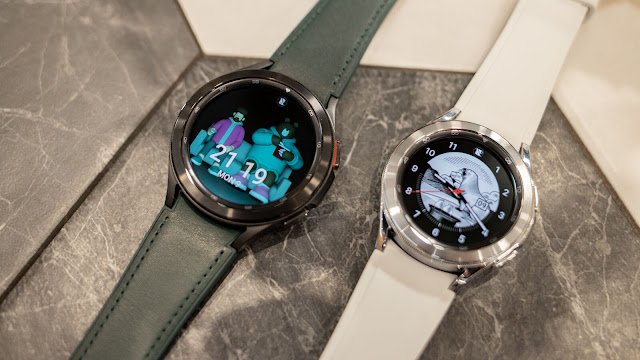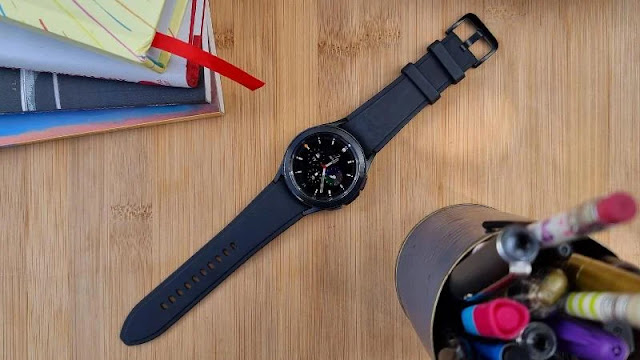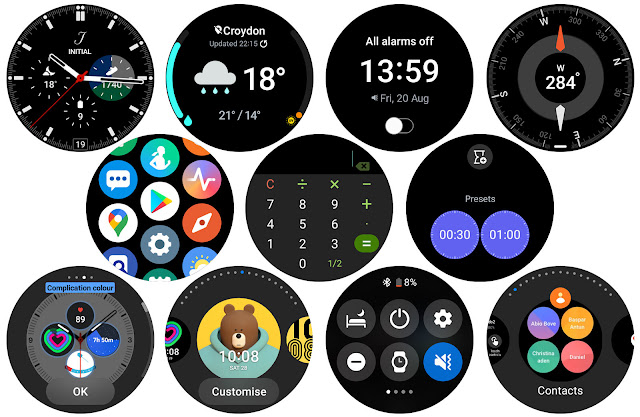The Watch 4 series offers itself up in two distinct styles – including the more traditional Classic – while also serving as the debut platform for the new iteration of Wear OS.
Should I Buy The Samsung Galaxy Watch 4 Classic?
Pros
- Wear OS works better than ever
- Tasteful, tactile design
- Feature-packed
- Great performance
Cons
- Some Samsung phone-exclusive features
- Price premium for Classic styling
- Wear OS 3 with caveats
Our Verdict
Price When Reviewed
- From $349.99
Samsung's August Unpacked event was something of a transformative affair, with the Z Fold 3 acting as a stand-in for the Galaxy Note line, while the company's new Galaxy Watch 4 family served as the debut for Google's jointly-revitalised Wear OS platform.
Not since 2014's Galaxy Gear Live has a Samsung smartwatch run on Google's wearable operating system. In the interim, the Korean company has forged ahead with its own Tizen OS; landing itself the number two position in the global wearables market while Wear OS was relegated to the platform of choice for lesser-known manufacturers and newcomers.
As such, the Watch 4 line doesn't just demonstrate Samsung's proficiency in creating compelling smartwatches but the company's ability to collaborate and reshape an unloved rival platform into something that users may actually come to embrace.
Design And Build
- Classic follows more traditional watch styling
- Rotational input via physical bezel
- Supports third-party straps
- Elegant yet hardy
Samsung hasn't used the 'Classic' naming convention since its smartwatches bore the 'Gear' name, however, the Watch 4 line reestablishes the trend with two distinct styles, manifesting in the Watch 4 and Watch 4 Classic.
The 'Classic' name speaks to this watch's more traditional styling and design influences – swapping out the standard Watch 4's contemporary geometry and flat glass front for a timepiece that leans more heavily on the aesthetics of a typical mechanical watch.
While the sensor placement, buttons and screen remain consistent across both styles of Watch 4, the Classic sports a more substantial stainless steel casing and – more importantly – a physical rotating bezel in place of the standard model's touch-based alternative.
Similarly to last year's Galaxy Watch 3, the Classic can be had in two casing sizes: 42mm and 46mm, with both being notably heavier and thicker than the sleeker aluminium-bodied Watch 4. The standard model comes in four colours (across both casing sizes), while the Classic comes in just two: either black or silver, regardless of casing size.
 |
| Black 46mm Classic w/ green Hybrid Leather strap [left]. Silver 42mm Classic w/ white Ridge-Sport Band [right] |
The smaller 42mm Watch 4 Classic (tested here) also happens to be the thickest entry in the line (at 11.2mm), however, the variant's added weight and thickness – compared to the standard models – doesn't really translate into real-world wear; still feeling like a relatively unobtrusive smart timepiece that looks the part. All I would say, with regards to its proportions, is that the 46mm model makes for a better fit on my near-7in/17cm wrists, compared to the smaller casing size featured in this review.
By default, the Watch 4 Classic comes pre-fitted with the Galaxy Watch 4 Ridge-Sport Band, however, in markets where the Samsung Design Studio is available, buyers can pick their band type, size and colour at purchase, which also includes the option of the Sport, Hybrid Leather and Extreme Sport Bands too. Bands can also be bought separately, so you can mix and match as desired.
Like the Watch 3, there are two physical buttons on the Classic's right side (although they're less prominent and rectangular, rather than round), with a red accent surrounding the edge of the top button. The hardware here is also IP68 dust and water-resistant, swim-proof up to 5ATM and MIL-STD-810G certified (which tests against extreme temperatures, shock and the like); repelling scratches and nicks surprisingly deftly too.
Opt for the Classic if you're after a smartwatch that looks more watch than wearable tech and if you think you'll appreciate the greater level of tactility offered by its physical bezel, otherwise the contemporary stylings of the standard Watch 4 might make for a better fit.
Display And Audio
- Beautifully crisp display
- Rich always-on watch face options
- Responsive tilt-to-wake
- Bluetooth audio support
Two casing sizes means two display sizes too, with the 42mm build sporting a 1.19in 396x396 circular screen and the 46mm version toting a 1.36in panel, with a 450x450 resolution – resulting in comparatively crisp pixel density across both sizes. These are identical to the displays found on the 40mm and 44mm standard Watch 4's respectively, too.
The Super AMOLED panels used deliver a rich viewing experience, facilitated by excellent contrast and wonderfully vibrant colours, while the use of OLED tech means they're ideal for supporting the watch's always-on display functionality too.
In terms of control, Samsung has gone above and beyond expected features – like automatic and manual brightness control, its various screen wake settings and screen timeout options – including extras like enhanced touch sensitivity for use with gloves and a wealth of accessibility features, including colour and magnification controls.
There are over 20 watch faces available on-watch out the box, practically all of which feature some degree of personalisation or customisation, such as complications that convey additional information like steps, weather, battery percentage and more. If you want even more faces, they can be downloaded directly on-watch, straight from the Google Play Store.
Tilt-to-wake felt pleasingly responsive to the point that – outside of testing – I felt no need to switch on the always-on display, however, it's there for those who prefer such functionality (at the expense of some longevity).
In most cases, always-on faces retain an impressive amount of information compared to their standard iterations, with most only dropping more demanding elements (such as a constantly animated second hand) while still delivering colour and detail that you might otherwise expect to fall by the wayside.
An integrated microphone and speaker also feature, with surprisingly good performance – in terms of firing queries to the assistant or taking calls directly on the watch. The speaker is clear but lacks any sort of bass – which isn't surprising given the tiny amount of room Samsung is working with here – making it a functional inclusion but certainly not one to enjoy music with.
Software And Features
- 'Wear OS powered by Samsung' feels slick
- Exclusive Wear OS features at launch (like offline Spotify playback)
- Rich app and watch face ecosystem
- No access to Google Assistant (at launch)
Wear OS – Google's long-standing but unloved wearables platform – has only ever really existed as an awkward background character in the smartwatch space, while Apple's watchOS and Samsung's Tizen-based wearables have held the spotlight.
In something of a surprise move, Google announced its partnership with Samsung on the next iteration of Wear OS back at Google I/O 2021, and the Watch 4 and Watch 4 Classic are the first smartwatches to market that represent the fruits of this newly-minted tag team.
As such, while those who've used Wear OS watches in the past will recognise that apps come from the Play Store and Google-made offerings like Google Fit and Google Maps are supported too (something previously not possible on Samsung's Tizen-powered watches), the voice assistant (at launch, at least) is solely Samsung's less-capable Bixby, Samsung Pay is the only NFC payment app accessible by hardware shortcut (even if you have Google Pay set up) and a number of other apps and icon designs mirror that of One UI, as it appears on Samsung's phones.
Speaking of feature set, the Classic serves up obvious entries like a calendar, contacts, phone, messages, weather, timers, alarms and the like, alongside some more specialist offerings, such as a compass, voice recorder and Samsung Pay. As with watch faces, apps are now sourced from the Google Play Store, addressing perhaps one of the biggest shortcomings of previous Galaxy Watches – third-party app support.
Companies like Spotify have also promised new functionality (initially exclusive to the Watch 4 line) in offline playback support, which reinforces the industry's reawakened awareness of Wear OS and Google's/Samsung's efforts to try and ensure the platform remains capable and competitive.
For those familiar, it's arguably one of the most consistent UI elements to carry over from Sammy's Tizen-based smartwatches and better yet, they're intuitive to work with; easily added, removed and reordered on the fly.
Fitness And Tracking
- Samsung Health offers well-rounded tracking
- Separate Samsung Health Monitor app is needed for full functionality
- Some features are Samsung Galaxy phone-exclusive
- Detailed health and sleep tracking (thanks, in part, to BIA sensor)
What Samsung calls its 'BioActive Sensor' is really an umbrella term for the multitude of sensors that the Watch 4 Series possesses; tracking metrics including heart rate and blood oxygen.
The ECG feature and Afib (irregular heartbeat) detection – which took time to find approval on the Watch 3 (and Watch Active 2) – are available from the get-go on the Watch 4 line (market dependant), while this year's wearable also debuts a new BIA (bioelectrical impedance analysis) sensor, which adds body composition analysis to the Galaxy Watch's already long list of fitness and wellbeing features.
As ever in the consumer wearables space, metrics like this are only ever meant to serve as a handy guide and don't constitute as medically approved data, however, for fitness fanatics that hold value in 'the quantified self', the Watch 4/4 Classic's body composition analysis feature is an impressive new addition to have on a wearable.
With the exception of ECG and blood pressure functionality, which (somewhat frustratingly) operate via a separate Samsung Health Monitor app (that only works on compatible Samsung Galaxy devices), all health tracking is recorded via Samsung Health.
Samsung Health on the Classic comes pre-loaded with 13 trackable activities but there are over 80 to choose from in all; with both phone-free route tracking and elevation tracking available (when appropriate), thanks to the watch's integrated GPS and baro-altimeter.
Performance And Battery
- Smooth user experience
- Decent battery life
- Faster charging would have been nice
Hardware-wise, perhaps one of the biggest upgrades to the Galaxy Watch 4 Series comes in the form of Samsung's new Exynos W920 chipset, which moves from the Watch 3's 10nm process down to a significantly smaller and more efficient 5nm process.
On a technical level, Samsung claims the W920 offers “1.25x faster processing compared to the Exynos 9110” and “8.8x smoother graphics performance”, while 1.5GB of RAM and double the onboard storage (now 16GB) cumulatively paint the Watch 4 family as something of a powerhouse in the current wearables space.
In real-world use, although the Watch 4 Classic takes a fair long while to initially boot up, once it's running, it proves consistently smooth and responsive. Apps never crashed, UI elements never bugged out and performance seemed rock-solid over a month's worth of wear. As mentioned before, sensor accuracy and automated workout and sleep detection proved competent too.
Despite the two different casing (and screen) sizes that the Classic comes in, Samsung quotes "up to" 40 hours of use per wear across the line. Longevity will obviously vary depending on your usage habits, with factors like fitness tracking, the always-on display and LTE connectivity (if you opt for the cellular model) all having a significant impact on wear time between charges.
Using out-of-box settings and wearing the 42mm Watch 4 Classic overnight (for sleep tracking purposes), this can be a two-day watch; lasting from 9:30am on day one to 9:30pm on day two (where charge reached 11%), just shy of Samsung's quoted longevity.
The impact of enabling additional features – like blood oxygen monitoring and snore detection during sleep tracking – proved negligible on the watch's 247mAh battery (the 46mm model features a 361mAh battery), with the watch suggesting a switch to power saving mode at 15% charge and watch-only mode at 5% charge.
For those considering the Watch 4 for its fitness tracking abilities, a 45-minute home circuit workout resulted in 3% battery drain on the Classic, while a 40-minute 5K run (which included GPS route tracking) amounted to an 11% drain, in testing.
As for recharging, the 42mm Watch 4 Classic refilled slower than I expected, reaching 100% in exactly 1 hour 25 on a regular basis, reaching about a day's worth of charge after 30 minutes.
The Watch 4 Classic does at least remind you to charge it two hours prior to your expected bedtime, to ensure there's enough juice for sleep tracking purposes; something I wish other watches with such functionality offered.
Price And Availability
Samsung unveiled the Galaxy Watch 4 family on 11 August, and the 4 and 4 Classic later went on sale, starting 27 August.
As with the standard Watch 4 – which costs £/€/US$100 less – as well as two casing sizes, price is affected by the Bluetooth/WiFi and LTE cellular connectivity split on offer, with 4G adding about £40/€50/US$50 to the asking price.
The 42mm Classic costs £349/€369/US$349.99 and the 4G model costs £389/€419/US$399.99, while the 46mm version costs £369/€399/US$379.99 or £409/€449/US$429.99 for the Bluetooth-only and 4G builds, respectively.
In most markets, the Watch 4 Classic is available from Samsung directly (UK/US/France/Germany/Spain), as well as retailers, including Amazon (UK/US/France/Germany/Spain), John Lewis (in the UK) and Best Buy (in the US).
Verdict
The Samsung Galaxy Watch 3 was already an incredibly capable foundation on which to build from. By splitting the Watch 4 Series into standard and Classic design styles, Samsung is giving users heaps more choice this time around, as well.
The balance of functionality, quality and performance here is practically unrivalled in the smartwatch space, however, the best experience is undoubtedly closed off to those who don't already own a compatible Samsung Galaxy smartphone.
There's also the 'Classic' premium to consider. Beyond the more traditional styling and physical bezel that this iteration of the Watch 4 possesses, there's little else that differentiates it from the standard variant, making the fact that it costs £/€/US$100 more a not-insignificant consideration for those tempted.
Specs
- 1.19in 396x396 or 1.36in 450x450 circular AMOLED always-on display (42mm)
- Gorilla Glass DX+
- 1.18GHz dual-core Exynos W920 5nm processor
- 1.5GB RAM
- 16GB ROM
- Wear OS Powered by Samsung
- One UI Watch
- Bluetooth 5.0
- NFC
- GPS
- WiFi
- 4G LTE (optional)
- Microphone
- Speaker
- Knox security
- Optical heart rate sensor (PPG)
- Electrical heart sensor (ECG)
- Bioelectrical impedance analysis sensor (BIA)
- Blood oxygen tracking
- AFib irregular heartbeat detection
- Sleep tracking
- Snore detection
- Body composition analysis
- Guided workouts
- Bixby Voice
- Gesture controls
- Stainless steel casing
- 5ATM swim-proof
- IP68-certified dust/water resistance
- MIL-STD-810G tested
- Wireless charging (inc. Qi charging)
- 247mAh battery (42mm)
- 361mAh battery (46mm)
- 41.5 x 41.5 x 11.2mm (42mm)
- 45.5 x 45.5 x 11mm (46mm)
- 46.5 grams (42mm)
- 52 grams (46mm)
- Colours: Black, silver
- Compatible with Android 6.0 or higher (devices require more than 1.5GB RAM)


















0 comments:
Post a Comment